Unit 5 Do you have a soccer ball? Section A 1a-2d- 课件+嵌入音频(共27张PPT)
文档属性
| 名称 | Unit 5 Do you have a soccer ball? Section A 1a-2d- 课件+嵌入音频(共27张PPT) | 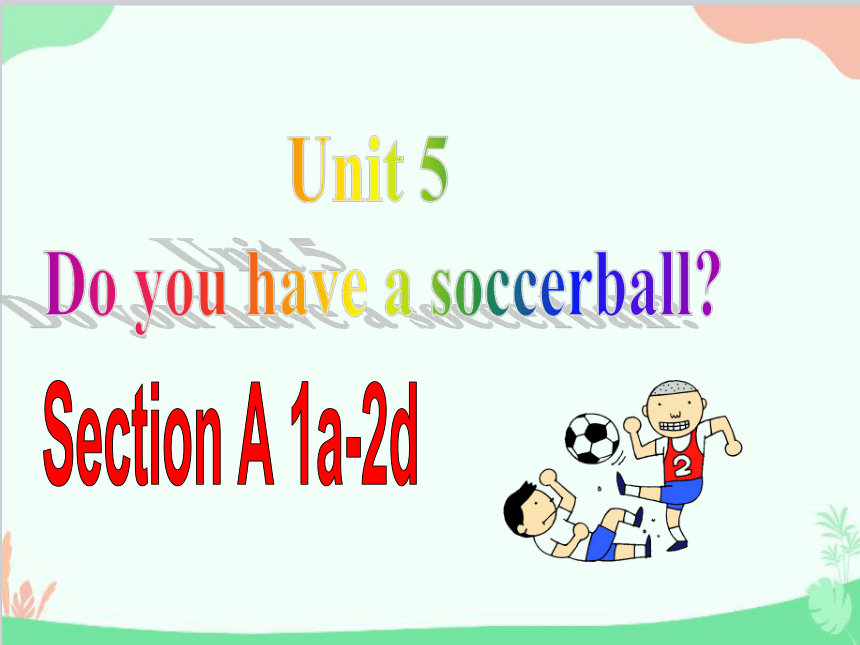 | |
| 格式 | pptx | ||
| 文件大小 | 5.1MB | ||
| 资源类型 | 教案 | ||
| 版本资源 | 人教新目标(Go for it)版 | ||
| 科目 | 英语 | ||
| 更新时间 | 2022-10-16 18:33:02 | ||
图片预览

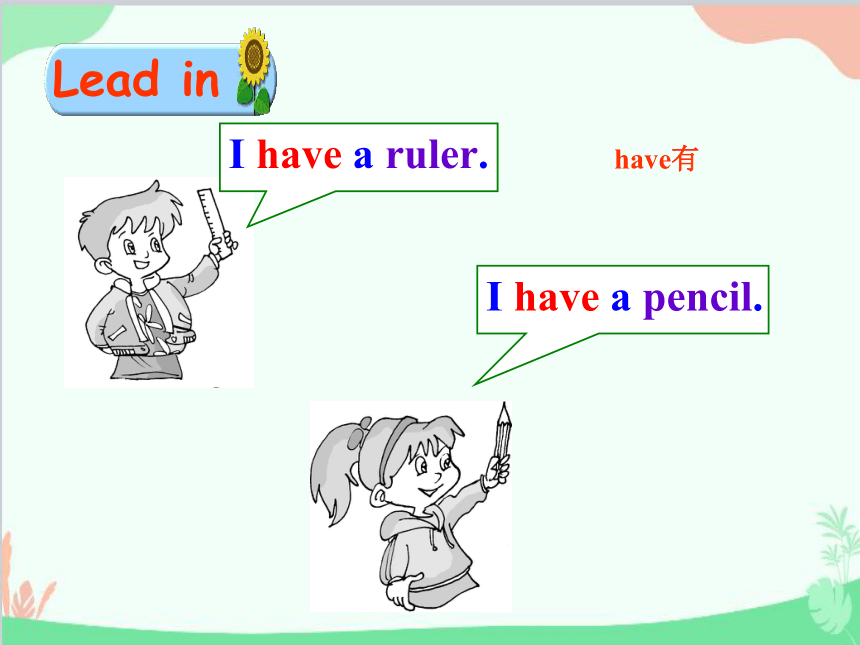

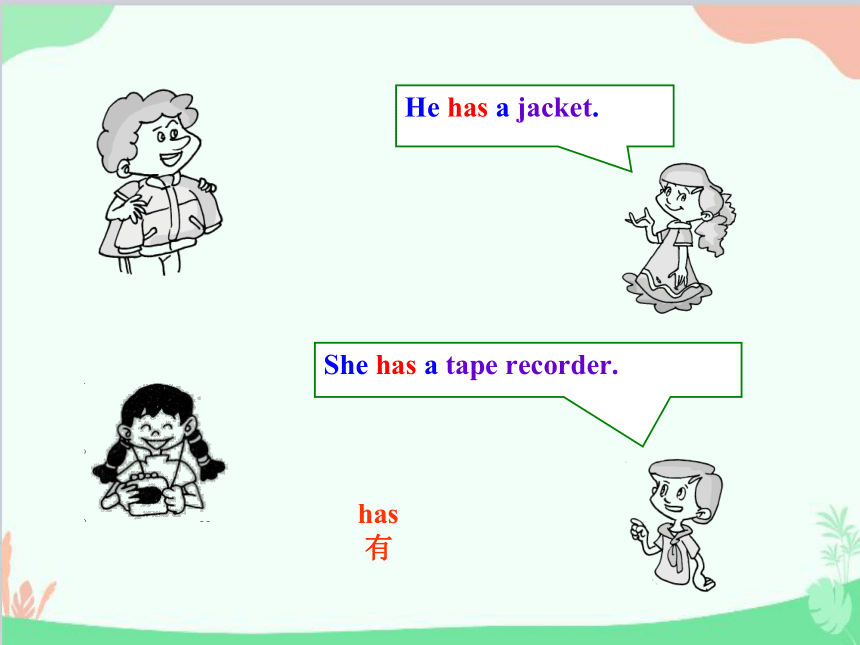
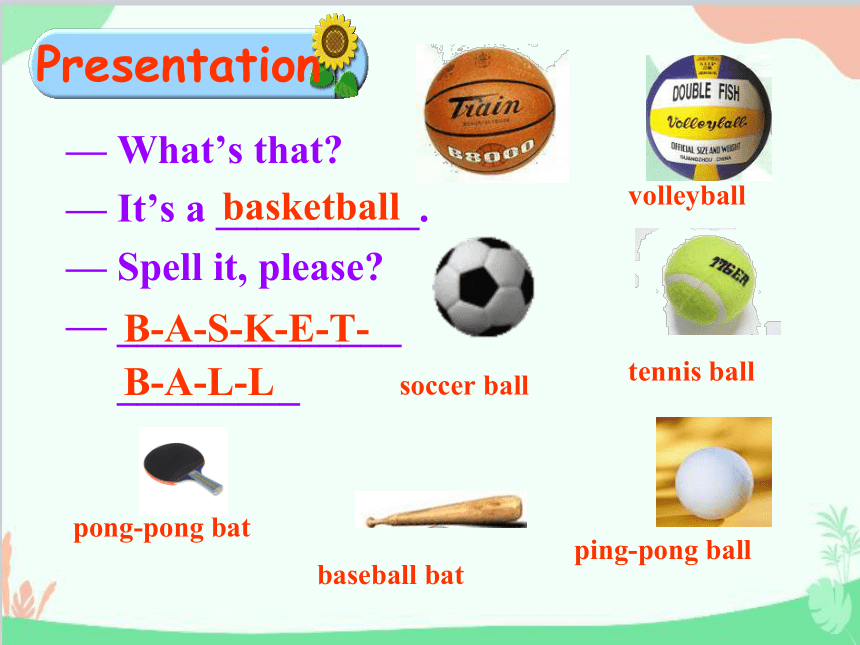

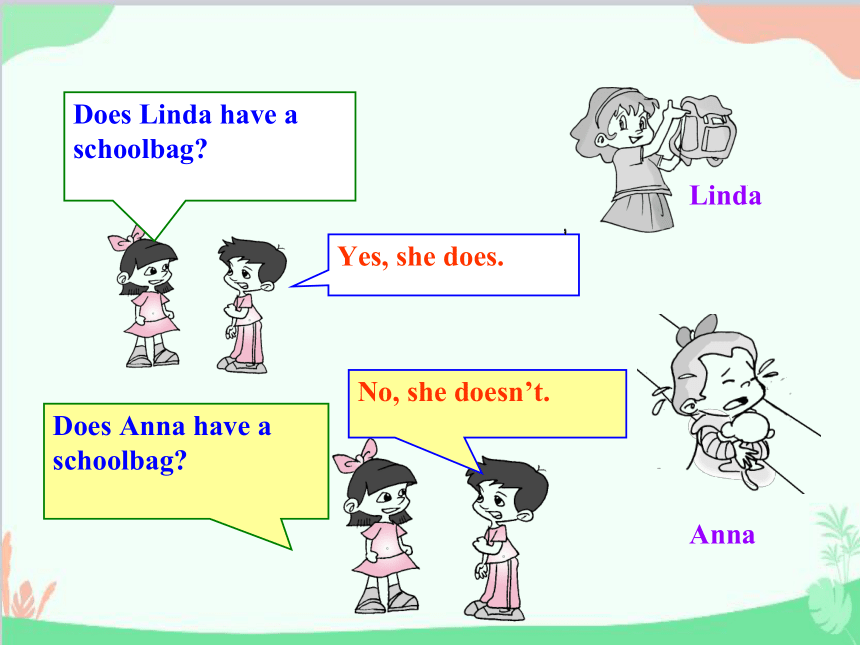

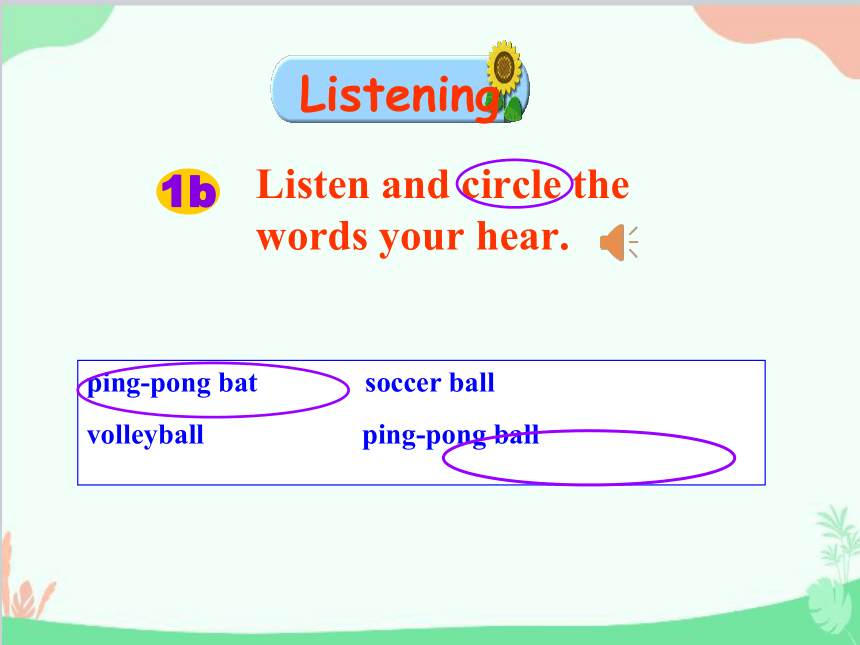
文档简介
(共27张PPT)
Section A 1a-2d
Unit 5
Do you have a soccerball
I have a ruler.
Lead in
I have a pencil.
have有
pencil box
dog
ruler
I have a baseball.
Where is it
It’s under the table.
I have a ____.
Where’s it
It’s in/on/under
____.
He has a jacket.
She has a tape recorder.
has
有
Presentation
— What’s that
— It’s a __________.
— Spell it, please
— ______________
_________
basketball
B-A-S-K-E-T-B-A-L-L
soccer ball
volleyball
tennis ball
ping-pong ball
baseball bat
pong-pong bat
Presentation
Do you have a sister
Yes, I do.
Do you have a cat
Yes, I do.
Do you have a baseball
No, I don’t.
Does Linda have a schoolbag
Yes, she does.
Does Anna have a schoolbag
No, she doesn’t.
Linda
Anna
1. tennis ball __
2. ping-pong bat__
3. soccer ball __
4. volleyball __
5. basketball __
6. baseball bat __
a
f
c
e
d
b
Match the words with the things in the picture.
1a
Listening
Listen and circle the words your hear.
ping-pong bat soccer ball
volleyball ping-pong ball
1b
Pairwork
Do you have a
ping-pong bat
Yes, I do.
Do you have a
ping-pong ball
No, I don’t.
Practice the conversation with your partner. Then ask and answer questions about the things in the picture below.
1c
Practice
Do you have a
…
Yes, I do./
No, I don’t.
Listen and number the things [1-4].
1
Listening
3
2
4
2a
Listen again. Match the pictures in 2a with the balls.
Listening
1
2
3
4
2b
Pairwork
Ask and answer about the people in 2a.
Does Jane have a tennis ball
No, she doesn’t.
2c
Practice
Does … have a
______
Yes, …
No, …
Dale
Paul
Mike
Reading
Read the dialogue in 2d. Then
match the things with the right places.
Helen’s
baseball bat
baseball
jacket
hat
We don’t know.
2d
Cindy: Hey, Helen, let’s go! We’re late.
Helen: OK.
Cindy: Do you have the baseball
Helen: Yes, I do. It’s in my bag.
Cindy: And where’s our baseball bat
Helen: Bill has it.
Cindy: Oh, yeah. And do you have your jacket
Helen: Oh, no, I don’t. It’s on the chair. Let me get it.
Cindy: And your hat, too!
Helen: OK, I have my jacket and hat. Let’s go.
Pairwork
Role-play the conversation.
2d
have作动词,意为“有”,一般指某人拥有某物,侧重于所属关系。其第三人称单数形式
是has。
常用句式为:某人 + have/has + 某物,表示“人有某物”。在一般现在时态中,当主语为第三人称单数形式时,用has的形式。
e.g. I have a good friend. 我有一个好朋友。
She has a new pen. 她有一支新钢笔。
Explanation
3. we是人称代词主格,意为“我们”,在句子中作主语。
e.g. We are good friends. 我们是好朋友。
We have a new soccer ball.
我们有一只新足球。
2. late “迟到” 是个形容词,常用 be late 的结
构。
e.g. Xiao Ming is always late.
小明总是迟到。
4. us “我们”。 是we的宾格形式,在句子中放在
介词或动词后作宾语。
【辨析】we / us / our
we “我们” 是人称代词主格形式,作句子的主语。
us “我们”是人称代词宾格形式,作句子的宾语。
our “我们的”是形容词性物主代词,放在名词前。
e.g. We are in Mike’s room. 我们在迈克的房间里。
Call us at 457-3287. 给我们打电话457-3287.
Our teacher is in the classroom.
我们的老师在教室里。
5. 以动词let开头的祈使句,表示向别人提
建议,意思是“让……做……吧”。
基本结构为:let sb. do sth.,表示 “让某
人做某事”,表示说话人的建议。其中sb.
可由名词或代词宾格来充当,其后的动
词一定要用动词原形。
e.g. Let me do it. 让我来做吧。
Let him guess. 让他猜一猜。
6. let’s是let us 的缩写形式,意思为“咱们一起做某事吧”,通常表示建议、请求或命令。
肯定回答:一般用“OK”,“All right”,
“Yes, let’s …”;
否定回答:一般用“Sorry, I …” 。
e.g. — Let’s go! 让我们走吧!
— OK. 好吧。
Let’s look at the blackboard.
让我们看黑板吧。
一、 看图说出下列物品的英语单词。
Exercises
basketball
soccer ball
volleyball
baseball
baseball bat
ping-pong ball
ping-pong bat
tennis
二、 句型转换
1. Do you have a map (作肯定回答)
2. Do you have an English dictionary (作否定回答)
3. Does Linda have an eraser (作肯定回答)
4. Does he have a volleyball (作否定回答)
5. I have a nice ping-pong bat. (用she来代替I)
______ _______ a nice ping pong bat.
Yes, I do.
No, I don’t.
Yes, she does.
No, he doesn’t.
She has
三、 根据汉语提示完成句子。
1. 你有一只棒球拍吗?
_____ you ______ a baseball _____
2. 埃里克有一个网球吗?
_____ Eric ______ a _______ ball
3. 戴尔有一个足球和一个排球。
Dale _____ a ______ ball and a _________.
4. 我有一个篮球和一只乒乓球拍。
I _____ a _________ and a ping pong ____.
Do have
Does have tennis
has soccer volleyball
have basketball
bat
bat
1. 复习记忆本课所学的生词。
2. 编写三个问答句:
分别询问一下你的朋友有basketball,
soccer ball和volleyball吗?
Homework
Thank You!
Section A 1a-2d
Unit 5
Do you have a soccerball
I have a ruler.
Lead in
I have a pencil.
have有
pencil box
dog
ruler
I have a baseball.
Where is it
It’s under the table.
I have a ____.
Where’s it
It’s in/on/under
____.
He has a jacket.
She has a tape recorder.
has
有
Presentation
— What’s that
— It’s a __________.
— Spell it, please
— ______________
_________
basketball
B-A-S-K-E-T-B-A-L-L
soccer ball
volleyball
tennis ball
ping-pong ball
baseball bat
pong-pong bat
Presentation
Do you have a sister
Yes, I do.
Do you have a cat
Yes, I do.
Do you have a baseball
No, I don’t.
Does Linda have a schoolbag
Yes, she does.
Does Anna have a schoolbag
No, she doesn’t.
Linda
Anna
1. tennis ball __
2. ping-pong bat__
3. soccer ball __
4. volleyball __
5. basketball __
6. baseball bat __
a
f
c
e
d
b
Match the words with the things in the picture.
1a
Listening
Listen and circle the words your hear.
ping-pong bat soccer ball
volleyball ping-pong ball
1b
Pairwork
Do you have a
ping-pong bat
Yes, I do.
Do you have a
ping-pong ball
No, I don’t.
Practice the conversation with your partner. Then ask and answer questions about the things in the picture below.
1c
Practice
Do you have a
…
Yes, I do./
No, I don’t.
Listen and number the things [1-4].
1
Listening
3
2
4
2a
Listen again. Match the pictures in 2a with the balls.
Listening
1
2
3
4
2b
Pairwork
Ask and answer about the people in 2a.
Does Jane have a tennis ball
No, she doesn’t.
2c
Practice
Does … have a
______
Yes, …
No, …
Dale
Paul
Mike
Reading
Read the dialogue in 2d. Then
match the things with the right places.
Helen’s
baseball bat
baseball
jacket
hat
We don’t know.
2d
Cindy: Hey, Helen, let’s go! We’re late.
Helen: OK.
Cindy: Do you have the baseball
Helen: Yes, I do. It’s in my bag.
Cindy: And where’s our baseball bat
Helen: Bill has it.
Cindy: Oh, yeah. And do you have your jacket
Helen: Oh, no, I don’t. It’s on the chair. Let me get it.
Cindy: And your hat, too!
Helen: OK, I have my jacket and hat. Let’s go.
Pairwork
Role-play the conversation.
2d
have作动词,意为“有”,一般指某人拥有某物,侧重于所属关系。其第三人称单数形式
是has。
常用句式为:某人 + have/has + 某物,表示“人有某物”。在一般现在时态中,当主语为第三人称单数形式时,用has的形式。
e.g. I have a good friend. 我有一个好朋友。
She has a new pen. 她有一支新钢笔。
Explanation
3. we是人称代词主格,意为“我们”,在句子中作主语。
e.g. We are good friends. 我们是好朋友。
We have a new soccer ball.
我们有一只新足球。
2. late “迟到” 是个形容词,常用 be late 的结
构。
e.g. Xiao Ming is always late.
小明总是迟到。
4. us “我们”。 是we的宾格形式,在句子中放在
介词或动词后作宾语。
【辨析】we / us / our
we “我们” 是人称代词主格形式,作句子的主语。
us “我们”是人称代词宾格形式,作句子的宾语。
our “我们的”是形容词性物主代词,放在名词前。
e.g. We are in Mike’s room. 我们在迈克的房间里。
Call us at 457-3287. 给我们打电话457-3287.
Our teacher is in the classroom.
我们的老师在教室里。
5. 以动词let开头的祈使句,表示向别人提
建议,意思是“让……做……吧”。
基本结构为:let sb. do sth.,表示 “让某
人做某事”,表示说话人的建议。其中sb.
可由名词或代词宾格来充当,其后的动
词一定要用动词原形。
e.g. Let me do it. 让我来做吧。
Let him guess. 让他猜一猜。
6. let’s是let us 的缩写形式,意思为“咱们一起做某事吧”,通常表示建议、请求或命令。
肯定回答:一般用“OK”,“All right”,
“Yes, let’s …”;
否定回答:一般用“Sorry, I …” 。
e.g. — Let’s go! 让我们走吧!
— OK. 好吧。
Let’s look at the blackboard.
让我们看黑板吧。
一、 看图说出下列物品的英语单词。
Exercises
basketball
soccer ball
volleyball
baseball
baseball bat
ping-pong ball
ping-pong bat
tennis
二、 句型转换
1. Do you have a map (作肯定回答)
2. Do you have an English dictionary (作否定回答)
3. Does Linda have an eraser (作肯定回答)
4. Does he have a volleyball (作否定回答)
5. I have a nice ping-pong bat. (用she来代替I)
______ _______ a nice ping pong bat.
Yes, I do.
No, I don’t.
Yes, she does.
No, he doesn’t.
She has
三、 根据汉语提示完成句子。
1. 你有一只棒球拍吗?
_____ you ______ a baseball _____
2. 埃里克有一个网球吗?
_____ Eric ______ a _______ ball
3. 戴尔有一个足球和一个排球。
Dale _____ a ______ ball and a _________.
4. 我有一个篮球和一只乒乓球拍。
I _____ a _________ and a ping pong ____.
Do have
Does have tennis
has soccer volleyball
have basketball
bat
bat
1. 复习记忆本课所学的生词。
2. 编写三个问答句:
分别询问一下你的朋友有basketball,
soccer ball和volleyball吗?
Homework
Thank You!
同课章节目录
- starters 预备篇(2012秋审查)
- Unit 1 Good morning !
- Unit 2 What’s this in English?
- Unit 3 What color is it ?
- Unit 1 My name's Gina.
- Section A
- Section B
- Unit 2 This is my sister.
- Section A
- Section B
- Unit 3 Is this your pencil?
- Section A
- Section B
- Unit 4 Where's my schoolbag?
- Section A
- Section B
- Unit 5 Do you have a soccer ball?
- Section A
- Section B
- Unit 6 Do you like bananas?
- Section A
- Section B
- Unit 7 How much are these socks?
- Section A
- Section B
- Unit 8 When is your birthday?
- Section A
- Section B
- Unit 9 My favorite subject is science.
- Section A
- Section B
